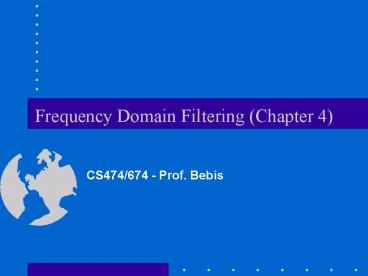filtering - PowerPoint PPT Presentation
Title:
filtering
Description:
image processing – PowerPoint PPT presentation
Number of Views:29
Title: filtering
1
Frequency Domain Filtering (Chapter 4)
- CS474/674 - Prof. Bebis
2
Frequency Domain Methods
Frequency Domain
Spatial Domain
3
Major filter categories
- Typically, filters are classified by examining
their properties in the frequency domain - (1) Low-pass
- (2) High-pass
- (3) Band-pass
- (4) Band-stop
4
Example
Original signal
Low-pass filtered
High-pass filtered
Band-pass filtered
Band-stop filtered
5
Low-pass filters(i.e., smoothing filters)
- Preserve low frequencies - useful for noise
suppression
Example
6
High-pass filters(i.e., sharpening filters)
- Preserves high frequencies - useful for edge
detection
Example
7
Band-pass filters
- Preserves frequencies within a certain band
Example
8
Band-stop filters
- How do they look like?
Band-stop
Band-pass
9
Frequency Domain Methods
Case 1 H(u,v) is specified in the frequency
domain. Case 2 h(x,y) is specified in the
spatial domain.
10
Frequency domain filtering steps
F(u,v) R(u,v) jI(u,v)
11
Frequency domain filtering steps (contd)
(case 1)
G(u,v) F(u,v)H(u,v) H(u,v) R(u,v)
jH(u,v)I(u,v)
12
Example
fp(x,y)
f(x,y)
fp(x,y)(-1)xy
F(u,v)
G(u,v)F(u,v)H(u,v)
H(u,v) - centered
g(x,y)
gp(x,y)
13
h(x,y) specified in spatial domainhow to
generate H(u,v) from h(x,y)?
- If h(x,y) is given in the spatial domain (case
2), - we can generate H(u,v) as follows
- Form hp(x,y) by padding with zeroes.
- 2. Multiply by (-1)xy to center its spectrum.
- 3. Compute its DFT to obtain H(u,v)
14
Example h(x,y) is specified in the spatial domain
600 x 600
Important need to preserve odd symmetry (i.e.,
H(u,v) should be imaginary) (read details on
page 268)
Sobel
15
Results of Filtering in the Spatial and
Frequency Domains
spatial domain filtering
frequency domain filtering
16
Low-pass (LP) filtering
- Preserves low frequencies, attenuates high
frequencies.
ideal
in practice
D0 cut-off frequency
17
Lowpass (LP) filtering (contd)
- In 2D, the cutoff frequencies lie on a circle.
18
Specifying a 2D low-pass filter
- Specify cutoff frequencies by specifying the
radius of a circle centered at point (N/2, N/2)
in the frequency domain. - The radius is chosen by specifying the percentage
of total power enclosed by the circle.
19
Specifying a 2D low-pass filter (contd)
- Typically, most frequencies are concentrated
around the center of the spectrum.
r8 (90 power)
r18 (93 power)
original
r radius
r43 (95)
r78 (99)
r152 (99.5)
20
How does D0 control smoothing?
- Reminder multiplication in the frequency domain
implies convolution in the time domain
time domain
freq. domain
21
How does D0 control smoothing? (contd)
- D0 controls the amount of blurring
r78 (99)
r8 (90)
22
Ringing Effect
- Sharp cutoff frequencies produce an overshoot of
image features whose frequency is close to the
cutoff frequencies (ringing effect).
hfg
23
Low Pass (LP) Filters
- Ideal low-pass filter (ILPF)
- Butterworth low-pass filter (BLPF)
- Gaussian low-pass filter (GLPF)
24
Butterworth LP filter (BLPF)
- In practice, we use filters that attenuate high
frequencies smoothly (e.g., Butterworth LP
filter) ? less ringing effect
n1
n4
n16
25
Spatial Representation of BLPFs
n1 n2 n5
n20
26
Comparison Ideal LP and BLPF
BLPF
ILPF
D010, 30, 60, 160, 460
D010, 30, 60, 160, 460
n2
27
Gaussian LP filter (GLPF)
28
Gaussian Frequency Spatial Domains
spatial domain
frequency domain
29
Example smoothing by GLPF (1)
30
Examples of smoothing by GLPF (2)
D0100
D080
31
High-Pass filtering
- A high-pass filter can be obtained from a
low-pass filter using
32
High-pass filtering (contd)
- Preserves high frequencies, attenuates low
frequencies.
33
High Pass (LP) Filters
- Ideal high-pass filter (IHPF)
- Butterworth high-pass filter (BHPF)
- Gaussian high-pass filter (GHPF)
- Difference of Gaussians
- Unsharp Masking and High Boost filtering
34
Butterworth high pass filter (BHPF)
- In practice, we use filters that attenuate low
frequencies smoothly (e.g., Butterworth HP
filter) ? less ringing effect
35
Spatial Representation of High-pass Filters
IHPF
BHPF
GHPF
36
Comparison IHPF and BHPF
IHPF
D030,60,160
D030,60,160
BHPF
n2
37
Gaussian HP filter
GHPF
BHPF
38
Comparison BHPF and GHPF
D030,60,160
BHPF
n2
D030,60,160
GHPF
39
Example High-pass Filtering and Thresholding
for Fingerprint Image Enhancement
BHPF (order 4 with a cutoff frequency 50)
40
Difference of Gaussians Frequency Spatial
Domains
This is a high-pass filter!
41
Difference of Gaussians Frequency Spatial
Domains (contd)
spatial domain
frequency domain
High-pass filter!
42
Frequency Domain Analysis of Unsharp Masking and
Highboost Filtering
Unsharp Masking
Highboost filtering (alternative definition)
previous definition
Frequency domain
43
Revisit Unsharp Masking and Highboost Filtering
Highboost Filter
44
Highboost and High-Frequency-Emphasis Filters
45
Example
GHPF
D040
High-emphasis
High-emphasis and hist. equal.
High-Frequency Emphasis filtering Using Gaussian
filter k10.5, k20.75
46
Homomorphic filtering
- Many times, we want to remove shading effects
from an image (i.e., due to uneven illumination) - Enhance high frequencies
- Attenuate low frequencies but preserve fine
detail.
47
Homomorphic Filtering (contd)
- Consider the following model of image formation
- In general, the illumination component i(x,y)
varies slowly and affects low frequencies mostly. - In general, the reflection component r(x,y)
varies faster and affects high frequencies mostly.
i(x,y) illumination r(x,y) reflection
IDEA separate low frequencies due to i(x,y)
from high frequencies due to r(x,y)
48
How are frequencies mixed together?
- Low and high frequencies from i(x,y) and r(x,y)
- are mixed together.
- When applying filtering, it is difficult to
handle - low/high frequencies separately.
49
Can we separate them?
- Idea
Take the ln( ) of
50
Steps of Homomorphic Filtering
- (1) Take
- (2) Apply FT
- or
- (3) Apply H(u,v)
51
Steps of Homomorphic Filtering (contd)
- (4) Take Inverse FT
- or
- (5) Take exp( ) or
52
Example using high-frequency emphasis
Attenuate the contribution made by illumination
and amplify the contribution made by reflectance
Attenuate the contribution made by illumination
and amplify the contribution made by reflectance
53
Homomorphic Filtering Example
54
Homomorphic Filtering Example































